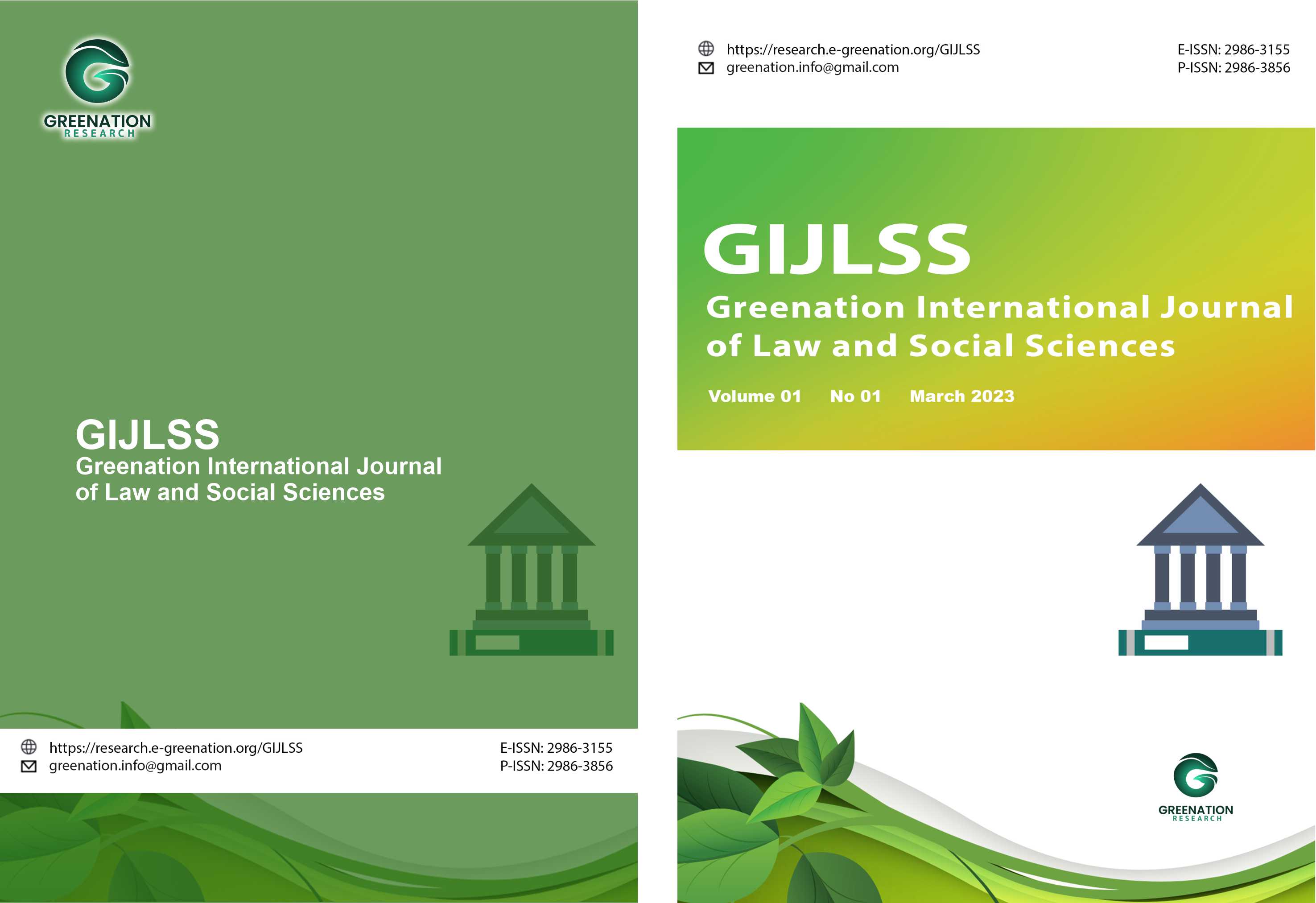Legal Formulation of the Use of Non-Organic Firearms of the TNI/Polri by Civilians for the Purpose of Self-Defense
DOI:
https://doi.org/10.38035/gijlss.v3i2.498Keywords:
Non-Organic Firearms, Martial Arts, Civil, Legal FormulationsAbstract
The possession and use of non-organic firearms of the TNI/Polri by civilians in Indonesia for the purpose of self-defense is a complex and multidimensional legal issue. On the one hand, the right to self-defense is recognized in the national legal system as part of human rights; But on the other hand, the misuse of firearms by civilians also has the potential to threaten public security and order. This study aims to examine how the legal arrangements regarding the use of non-organic firearms by civilians for self-defense purposes, how to apply to handle their abuse, and how should the ideal law enforcement formulation be for the use of such firearms. This study uses normative and empirical juridical methods with legal, conceptual, and comparative approaches, and is equipped with field data through interviews with law enforcement officials and firearms owners. The results of the study show that existing legal arrangements, such as Emergency Law Number 12 of 1951 and Police Chief Regulation Number 1 of 2022, have not been able to answer the challenges of implementation and supervision effectively. Weaknesses were found in the licensing process, the lack of post-permit supervision, and the absence of a psychological evaluation system and periodic audits of the use of weapons. Compared to other countries such as Japan, Singapore, and Australia, Indonesia lags behind in digitalization, data integration, and technology-based law enforcement. Therefore, a new legal formulation that is more adaptive, comprehensive, and oriented towards legal protection that is balanced between civil rights and public safety is needed.
References
Ali, S., & dkk. (2024). Problematika Perizinan Penguasaan Senjata Api Teramunisi untuk Sipil dalam Perspektif Hukum Positif Nasional. Demokrasi, 1(2), 112–127.
Ali, Z. (2016). Metode Penelitian Hukum. Sinar Grafika.
Alleman, M. (2000). Translation and Analysis of Japan’s Firearm and Sword Possession Control Law. Pacific Rim Law & Policy Journal, 9(1), 176–200.
Atmasasmita, R. (2003). Menata Kembali Masa Depan Pembangunan Hukum Nasional. Seminar Pembangunan Hukum Nasional VIII, 7.
Bentham, J. (1823). An Introduction to the Principles of Morals and Legislation. Clarendon Press.
Bloom, E. L., & rekan. (2020). Challenges in Firearm Regulation Enforcement: A Comparative Study. International Journal of Law and Politics, 12(4), 322–339. https://doi.org/10.5678/ijlp.2020.12.4.322
Chapman, D., Johnson, E., & Lee, R. (2019). Effect of Gun Buyback Programs on Firearm Violence. The Lancet Public Health, 4(7), e347--e356. https://doi.org/10.1016/S2468-2667(19)30188-4
Chapman, R. (2016). Gun Policy Reforms After the Port Arthur Massacre: What Australia Might Already Have Learned. The Conversation.
Detiknews. (2024). Pengusaha Penembak Ban Pajero di Demak Pakai Pistol Glock Berizin Resmi.
Diantha, I. M. P. (2016). Metodologi Penelitian Hukum Normatif dalam Justifikasi Teori Hukum. Prenada Media.
Friedman, L. M. (1975). The Legal System: A Social Science Perspective. Russell Sage Foundation.
Hidayat, R., & Nugroho, A. (2022). Implementasi Sistem Background Check. Jurnal Kebijakan Keamanan, 8(2), 75–90.
Junwaldi, D. J. N., Rahman, S., & Razak, A. (2023). Alasan Penggunaan Kekerasan dengan Senjata Api oleh Anggota Polri. Journal of Lex Theory (JLT), 3(2), 338–353. https://doi.org/10.52103/jlt.v3i2.1503
Kusnadi, S., Anwar, S. B., & Hidayat, R. (2022). Evaluasi Proses Verifikasi Calon Pemegang IKHSA. Jurnal Kriminologi Indonesia, 9(1), 157–176.
Kusumaatmadja, M. (1970). Fungsi dan Perkembangan Hukum dalam Pembangunan Nasional. Fakultas Hukum, Universitas Padjadjaran.
Kusumaatmadja, M. (1995). Hukum, Masyarakat, dan Pembinaan Hukum Nasional. Binacipta.
Marzuki, P. M. (2019). Penelitian Hukum (Revised edition). Kencana Prenada Media Group.
Megantara, A. R. (2021). Aspek Hukum Atas Senjata Api Bela Diri. Deepublish.
Narbuko, C., & Achmadi, A. (2016). Metodologi Penelitian. Bumi Aksara.
National Police Agency of Japan. (2023). Crime in Japan 2023.
Perhimpunan Pemilik Izin Khusus Senjata Api Bela Diri Indonesia (Perikhsa). (2023). Naskah Akademik Rancangan Peraturan Pemerintah Tentang Delegasi Wewenang dan Penyelenggaraan Perizinan Senjata Api Bela Diri Sipil Non?Organik TNI/POLRI.
Persatuan Menembak Indonesia (Perbakin). (2022). Pedoman Pelatihan dan Sertifikasi Menembak.
Pound, N. R. (1926). Law and Morals (2nd ed.). University of North Carolina Press.
Prasetyo, T., & Barkatullah, A. H. (2005). Politik Hukum Pidana: Kajian Kebijakan Kriminalisasi dan Dekriminalisasi. Pustaka Pelajar.
Priyatno, D. (2019). Kriminologi Perspektif Hukum Pidana. Sinar Grafika.
Qamar, N. (2016). Sosiologi Hukum. Mitra Wacana Media.
Rahardjo, S. (2009). Lapisan-Lapisan Dalam Studi Hukum. Bayumedia Publishing.
Rahman, M. G., & Tomayahu, S. (2020). Penegakan Hukum Di Indonesia. Jurnal Al-Himayah, 4(1), 142–159.
Setiawan, R., & Ningsih, M. D. (2022). Delegasi Wewenang Polri dalam Perizinan Senjata Api. Jurnal Hukum Dan Konstitusi, 16(1), 45–63.
Shidarta. (2006). Karakteristik Penalaran Hukum dalam Konteks Ke-Indonesiaan. CV Utomo.
Siagian, Y. M. (2024a). Reforming Firearms Regulation in Indonesia: Insights from U.S. and Australian Models. Jurnal Hukum & Pembangunan, 55(1), 100–120.
Siagian, Y. M. (2024b). Reforming Firearms Regulation in Indonesia. Jurnal Hukum & Pembangunan, 55(1), 100–120.
Sianturi, S. R. (1986). Asas?Asas Hukum Pidana di Indonesia dan Penerapannya. Alumni AHAEM?PTHAEM.
Simkin, K. E. (2021). Japan’s Firearms Control: A Model of Zero/Gun Crime (SPOT Report, Issue 2021/01).
Singapore Police Force. (2025). Overview of Gun Explosive Weapon Licences.
Smith, J. (2020). Transparency and Accountability in Firearms Regulation. International Journal of Law and Politics, 12(4), 322.
Soekanto, S. (2007). Faktor-Faktor Yang Mempengaruhi Penegakan Hukum. Raja Grafindo Persada.
Soerjono Soekanto and Budi Sulistyowati. (2015). Sosiologi: Suatu Pengantar. Rajawali Pers.
Soesatyo, B. (2024). Rekonstruksi Penegakan Hukum Pidana terhadap Penyalahgunaan Senjata Api. Jurnal Kriminologi & Keamanan, 12(2), 145–168.
Solikin, N. (2019). Hukum dan Perubahan Sosial: Mencermati Fungsi dan Perkembangan Hukum Secara Sosiologis. Pena Cendekia.
Susilo, D. K., & rekan. (2023). Analisa Tembak di Tempat yang Dilakukan oleh Anggota Polri terhadap Pelaku Kriminal dalam Upaya Penegakan Hukum Pidana. Legalitas: Jurnal Hukum, 12(3), 45–60. https://doi.org/10.1234/leg.v12i3.2023.45-60
Suwanda, I. W., & Suda, I. W. J. (2021). Peraturan Dan Prosedur Serta Mekanise Perijinan Senjata Api. Ganec Swara, 15(2), 1188–1197.
Weber, M. (1978). Economy and Society: An Outline of Interpretive Sociology. University of California Press.
World Health Organization. (2021). Global Report on Firearm Violence. WHO Press.
Downloads
Published
How to Cite
Issue
Section
License
Copyright (c) 2025 Heru Prakoso Sosrohamidjojo

This work is licensed under a Creative Commons Attribution 4.0 International License.
Copyright :
Authors who publish their manuscripts in this journal agree to the following conditions:
- Copyright in each article belongs to the author.
- The author acknowledges that the Greenation International Journal of Law and Social Sciences (GIJLSS) has the right to be the first to publish under a Creative Commons Attribution 4.0 International license (Attribution 4.0 International CC BY 4.0).
- Authors can submit articles separately, arrange the non-exclusive distribution of manuscripts that have been published in this journal to other versions (for example, sent to the author's institutional repository, publication in a book, etc.), by acknowledging that the manuscript has been published for the first time at GIJLSS.
























